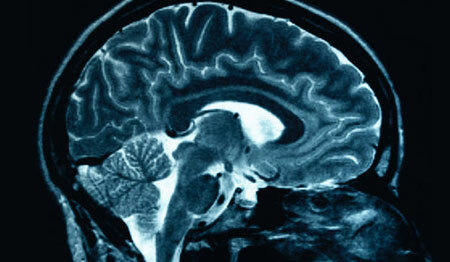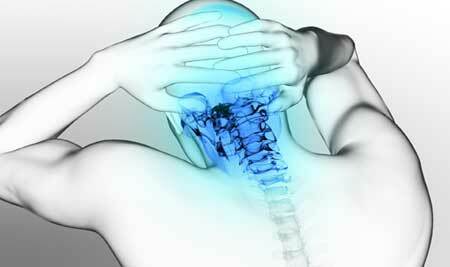What is it?
When a blood clot develops in the vein and inflammation of the inner wall occurs with a disturbance of blood flow, it is thrombophlebitis. It should be distinguished from phlebotrombosis, in which a thrombus is formed on an intact( non-inflamed) vascular wall. The course of the disease can be acute and chronic.

thrombophlebitis of superficial veins, photo 1
Acute thrombophlebitis is characterized by a more pronounced inflammation of the venous wall and an intense pain syndrome. Against this background, the risk of complications in the form of thrombosis and thromboembolism( the entry of a venous thrombus into the vessels of various organs) is significantly increased.
Pulmonary embolism is especially dangerous, which can lead to death if large diameter vessels are clogged.
Thrombophlebitis can affect the veins of both the upper and lower parts of the trunk. The latter option is the most common;to him predisposing features of hemodynamics( blood circulation).Acute thrombophlebitis of the lower extremities differs in the depth of localization of the affected vessels.
It is divided into:
- thrombophlebitis of superficial veins( photo 1);
- deep venous thrombophlebitis.
Content
- 1
- 2 Causes Symptoms of thrombophlebitis of the lower limbs, photo
- 3 diagnosis thrombophlebitis
- 4 Methods of treatment of thrombophlebitis of the lower limbs
- 5 forecast thrombophlebitis
- 6 Prevention
- 7 thrombophlebitis of the lower limbs in the ICD 10
Causes
appearance of venous thrombosis due to three main factors. They were first pointed out by the outstanding physiologist Rudolf Virkhov. Since then they are called the triad of Virchow and are the basis for understanding the mechanisms of the development of the disease:
- Reduction in the rate of blood flow in the vessel.
- Blood thickening due to a change in its composition.
- Violation of the integrity of the inner shell of the vessel.
These factors, both individually and in combination, are observed in certain diseases and conditions. Their presence is the background for the development of thrombophlebitis.
These include:
- a tendency to increased blood clotting due to hypercoagulable or increased platelet count;
- varicose veins( varicothrombophlebitis - the most common form of acute thrombophlebitis of superficial veins);
- forced long limb immobility( eg, immobilization after hip fracture, which can last for 3-6 months);
- the period of pregnancy and immediately after birth( at this time, the physiological activation of the clotting processes necessary to prevent bleeding in the postpartum period occurs, but in the presence of a damaged or inflamed venous wall this process can trigger massive thrombus formation);
- administration of hormones, especially estrogen-containing. They have a direct effect on the activation of clotting factors
systemic inflammatory process that develops in infectious diseases or in autoimmune cases when the immunity is directed against its own cells; - oncological diseases - most tumor cells release factors that stimulate the internal mechanism of blood clotting
damage and infection of the vein wall during injuries or intravenous injections, the installation of an intravenous catheter, and also during its long stay in a venous bed. This creates conditions for turbulent blood flow, in which platelet aggregation rises.
Symptoms of thrombophlebitis of lower extremities, photo

Symptoms of vascular injury, photo 2
The general picture of thrombophlebitis is formed from the manifestations of the inflammatory process and the symptoms of disturbance of normal blood flow in the affected veins. With superficial thrombophlebitis of the veins of the lower limbs, the symptoms are divided into general and local:
1. General symptoms of , indicating the presence of an inflammatory process. Typically, they are similar to flu-like syndrome symptoms. Therefore, very often with initial absence of local manifestations, diagnosis is difficult.
These include:
- increase in total body temperature;
- malaise, weakness;
- aches in muscles and joints.
2. Symptoms, defined directly above the affected vessel.
These are signs of local inflammation( photo2):
- densification and soreness of the vein during palpation;
- hyperemia( redness) and local skin temperature increase over the vein;
- lameness due to pain syndrome.
In deep vein thrombosis, clinical signs of thrombophlebitis of the lower extremities will be more pronounced( see photo).In addition to the flu-like syndrome and increasing local temperature in the limb, there are strong pains of a bursting nature, significant swelling, cyanosis( cyanosis).
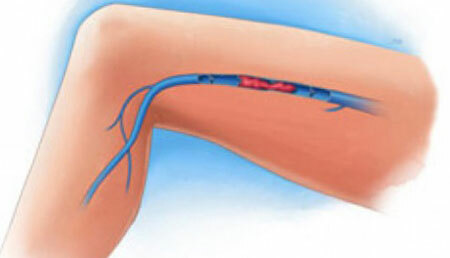
deep vein thrombophlebitis of lower extremities, photo 3
This symptomatology is defined below the level of blood flow blocked by a thrombus. According to statistics, the most common is the involvement in the pathological process of the veins of the lower leg and the lower third of the thigh.
Therefore, it is often enough in patients to determine the soreness with palpation of the gastrocnemius muscle and the pain when the foot is raised to the "on itself" position. The appearance of any of these signs, as well as "unexplained" puffiness is an indication for an urgent consultation of a phlebologist.
Diagnosis of thrombophlebitis
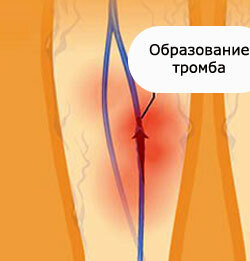 The diagnosis is made up of two stages - preliminary and final.
The diagnosis is made up of two stages - preliminary and final.
The first involves a thorough conversation between the doctor and the patient and conducting an objective examination - examination and palpation( probing).
In the second stage, additional diagnostic tests are assigned that help visualize the existing thrombus and assess the condition of the venous wall.
More detailed diagnosis of thrombophlebitis is as follows.
During the questioning of the patient, it is specified:
- when the disease occurred( with an acute thrombophlebitis there is a sudden onset, among full health);
- what was the initial manifestation( the first signs are pain and swelling of the limb);
- is there a connection with trauma, pregnancy and other factors, i.e.the presence of causal and predisposing conditions is revealed;
- whether the patient has congenital or acquired blood clotting disorders that increase the likelihood of thrombosis;
- experience of hormone intake especially with a contraceptive goal;
- what are the concomitant diseases besides thrombophlebitis. This is important for selecting the most rational therapy to minimize side effects.
When a patient is examined, the doctor evaluates a number of important signs that make it possible to judge the presence of thrombophlebitis and the possible development of complications:
1) The general condition of and the adequacy of vital functions such as respiration and circulation( evaluation of blood pressure and pulse, respiratory rate, body temperature).
2) The state of both lower limbs , determined visually and palpatory. It allows you to identify the presence of local symptoms - pain, redness, increased local temperature. The obligatory stage is to check the pulsation of the arteries of the extremities.
This makes it possible to exclude complete blockage by a thrombus of the blood supply vessel, which is dangerous with the development of gangrene of the extremity ending with amputation.
ECG is performed if there is shortness of breath and severe swelling of the affected limb. Based on the obtained graphic results, pulmonary embolism( PE) can be diagnosed.
For the final verification of this complication, an X-ray examination of the lungs is performed.
There are specific laboratory tests to determine the presence of thrombosis. These include:
- D-dimer plasma( less than 500 μg / l in normal) - its increase indicates thrombosis;
- deployed coagulogram( evaluates the state of coagulation and anticoagulation systems);
- Calculation of platelet count, performed with a general clinical analysis of blood.
Instrumental examination includes ultrasonic duplex scanning of vessels. With his help, the doctor receives valuable diagnostic information:
- state of permeability of the veins of the limbs;
- functional state of the valves of deep veins;
- presence of a thrombus in the lumen of the vein, its size, the likelihood of movement, "maturity"( "immature" thrombi are more dangerous, because it is easier to detach and spread by the current of blood);
- what patency have peripheral arteries.
When diagnosing "superficial thrombophlebitis", it is necessary to exclude the presence of other similar diseases:
- erysipelas;
- skin infections;
- inflammation of the lymphatic vessels( lymphangitis).
Note: it is more correct to use the term "thrombophlebitis of the lower extremities", and not "thrombophlebitis of the veins of the lower extremities", since "phlebitis" already means inflammation of the veins, i.e.a tautology is obtained.
Methods of treatment of lower limb thrombophlebitis

In acute attack of thrombophlebitis of the veins of lower extremities, the appearance of severe pain treatment should begin urgently - even by ambulance doctors, which must be called immediately.
Consists of adequate anesthesia and prevention of the progression of blood clots. To this end, heparin is administered iv once, aspirin inside, analgin IV.At present, low-molecular anticoagulants( for example, fractiparin) have replaced heparin. They have fewer side effects and high efficiency.
In the future, with the possibility of medical supervision and daily laboratory control of platelet levels, a 5-day course of anticoagulants is prescribed. In this case, preference is given to rivaroxaban - an indirect anticoagulant, the use of which does not increase the risk of massive bleeding.
Hospitalization in the department of vascular surgery is carried out in the absence of conditions for treatment outside the hospital, as well as at a high risk of development of life-threatening conditions.
It is indicated in the following cases:
- clinical, X-ray and electrocardiographic signs of PE;
- extensive thrombosis, confirmed by duplex scanning;
- thrombophlebitis of the hip( large saphenous vein), in which the risk of thromboembolism is increased many times;
- thrombophlebitis of the small saphenous vein of the lower leg;
- hollow venous thrombosis( upper and lower);
- clinical and laboratory deterioration on the background of treatment outside the hospital with superficial thrombophlebitis;
- detection of ultrasound of a mobile thrombus, which at any time can come off.
During transportation of the patient, it is necessary to give the affected limb an elevated position. In case of refusal from hospitalization, the patient is advised to immediately contact a polyclinic. At the same time, ambulance doctors carry out an active call of the local doctor to the house.
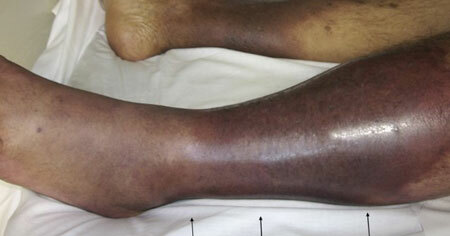
Treatment of thrombophlebitis of legs
In a hospital setting, the type and tactics of treatment are determined by a vascular surgeon.
The main therapeutic moments are:
- intensive anticoagulation( anti-coagulation) therapy( warfarin, heparin, enoxaparin);
- use of thrombolytic( thrombus-destroying) drugs - they are effective only in the first hours after the formation of a thrombus( for this reason it is worth immediately seeking medical help);
- non-steroidal anti-inflammatory drugs;
- antibiotic therapy when joining the infectious process;
- , in the absence of pain syndrome, elastic compression is performed( bandaging, wearing of elastic knits);
- control of platelet count and APTT( partially activated thromboplastin time) 1-2 times a day in the early days, then regularly throughout the entire period of hospitalization;
- early, but a gradual and cautious activation of the patient after the end of bed regimen, tk.risk of trombosis is high;
- prevention of thrombus penetration into the deep vein system. To this end, according to the testimony, Troyanov's surgery for dressing the large saphenous vein is performed( the decision is made individually in cases where thrombophlebitis is detected above the knee joint).
In order to prevent the appearance of new extremity veins in thrombophlebitis of the lower extremities, additional local treatment is performed. It consists in the use of various alcohol compresses, ointments of gels, etc.
Used ointments in the treatment of superficial thrombophlebitis of the lower limbs are classified into 3 groups:
- Heparin-containing( Lyoton, Hepatrombin) - reduces the risk of recurrent thrombosis.
- With non-steroidal anti-inflammatory components( indovazin, diclofenac, indomethacin), which allow quickly to stop the inflammatory reaction.
- Phlebotonic with rutoside, troxerutin( treskevazidom), strengthening the venous wall.
Prognosis for thrombophlebitis
 Acute superficial thrombophlebitis has a favorable prognosis in comparison with the deep one. After performing the necessary treatment, the symptoms quickly become redundant, but the veins may be retained for some time.
Acute superficial thrombophlebitis has a favorable prognosis in comparison with the deep one. After performing the necessary treatment, the symptoms quickly become redundant, but the veins may be retained for some time.
In the absence of treatment, the greatest danger is the penetration of a clot from the surface into the deep veins, which can aggravate the condition and lead to the development of deep thrombophlebitis.
In turn, deep vein thrombophlebitis of the lower limbs can be complicated by pulmonary embolism. Its development occurs when the embolization of the severed thrombus enters the pulmonary artery system.
The sudden onset of dyspnea in combination with swelling and pain in the leg may indicate the development of this complication. This shows the emergency hospitalization of the patient.
Prevention
Preventive measures for thrombophlebitis include:
- treatment of varicose veins, preventing their thrombosis and inflammation;
- wearing of elastic knitwear during pregnancy, high platelet count, hormone intake;
- early activation of the limb after fractures and other injuries, as well as prolonged bed rest;
- compliance with the rules of antiseptics for IV injection. Avoid medication in leg veins;
- careful monitoring of the condition of the intravenous catheter and its installation for no more than 3 days;
- administration of small doses of heparin and its analogues in the postoperative period in patients with varicose veins or cases of thrombophlebitis in the past;
- classes in physiotherapy, swimming;
- regular foot massage
Thrombophlebitis of lower extremities in the ICD 10
In the international classification of diseases, thrombophlebitis of the lower limbs is:
Class IX.Diseases of the circulatory system( I00-I99)
I80-I89 - Diseases of veins, lymphatic vessels and lymph nodes, not elsewhere classified
I80 - Phlebitis and thrombophlebitis
- I80.3 - Phlebitis and thrombophlebitis of lower extremities, unspecified


